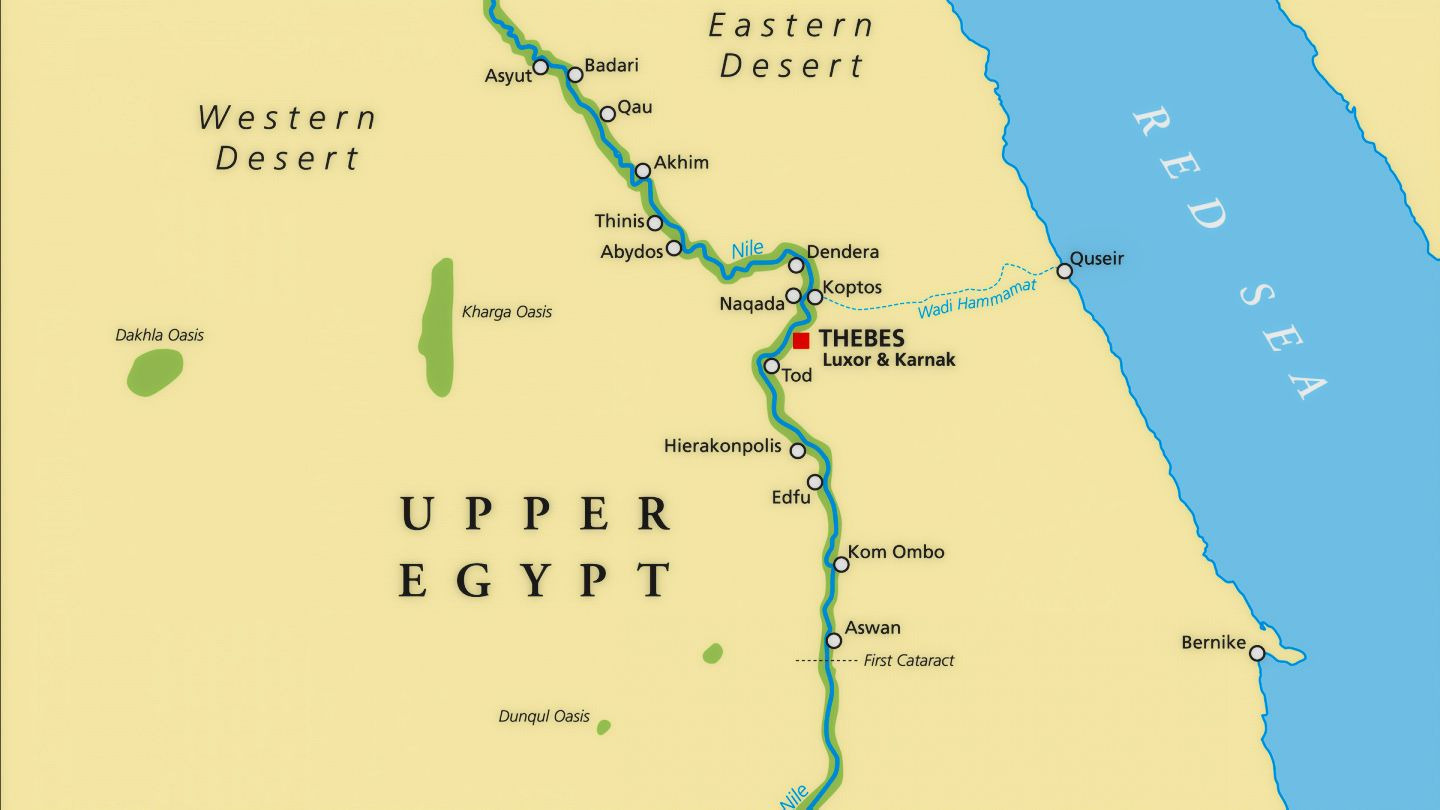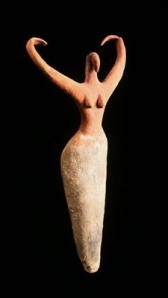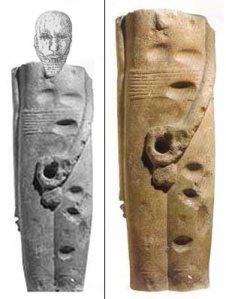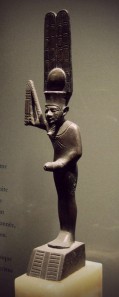I’m so used to thinking of Isis with Osiris that I can forget She is also paired with other Gods. Today, we’ll look at one of Them: the God of the Upright Phallus, Min.

Isis and Min shared a temple complex at Koptos (Gebtu in ancient Egyptian, Qift in modern). It is in Upper Egypt, near Denderah and Thebes. The site is connected to the Red Sea by the Wadi Hammamat (meaning “Valley of Many Baths), a dry riverbed. The wadi contains important 3,000-year-old petroglyphs; in ancient times, it led to major Egyptian mining areas and was a key trade route.
Koptos is also just across the Nile from Naqada, the site of the pre-dynastic culture that takes its name from the site. What is known as Naqada II (3500-3400 BCE) is the period to which the beautiful statuettes of the “Nile Goddess” or “Dancing Woman” are dated.

Koptos is an ancient, ancient sacred site and probably originally belonged to Min alone. Herodotus reports that the Egyptians considered Him their oldest Deity. Yet by at least the time of the New Kingdom, Isis is prominent there as well and Min becomes assimilated with Osiris. The temple to Isis and Min, the ruins of which we see today, was built under Ptolemy II, with additions made under succeeding pharaohs. There are remains of two more temples on the site. One is the Ptolemaic “middle temple” or “Osiris temple.” The other is a temple dedicated to Geb and Isis, probably begun under Nectanebo II and continued under the Ptolemies. There is literary evidence for a temple of Isis and Harpokrates, but its remains have not yet been found.
One of the interesting things about Koptos is that it was a popular oracular site. You can still see the small chamber to the rear of the Isis and Geb temple in which the entranced priest would sit to deliver the words of the Deity. This oracular chapel was built by Kleopatra VII (the famous one). The tradition of oracles at Koptos did not cease with the coming of Christianity. In a work called Theosophia, we have record of an oracle from Koptos that is ostensibly an Egyptian Pagan oracle, but since it discusses the unity of the Logos and the Father, a number of scholars think it was likely a Christian retrofit. Be that as it may, the point is that the tradition of oracles at Koptos was well established.

A particular Isiac relic at Koptos seems to have been a lock of Her hair. A Greek dedication to Her says it is “to the Great Goddess, Isis of the Hair.” We also have a record of a healing prayer made “near the hair at Koptos.” Plutarch explains the tradition for us, relating that when Isis first heard of the death of Osiris, She cut off a lock of Her hair and donned mourning dress. He notes that this is why the city there is called Koptos for some derive the name from Greek koptein, meaning “to deprive.” The cutting of hair is a Greek mourning tradition; Egyptian women simply wore theirs long and unkempt. (Read more about that tradition here.) Nevertheless, among both Greeks and Egyptians, Isis of Koptos was particularly known a Mourning Goddess.
The ancient Greek travel writer, Pausanias, in his Description of Greece, mentions Koptos as the site of a tragedy that befell a man who rashly entered Isis’ sanctuary there without a specific invitation from the Goddess:
I have heard a similar story from a man of Phoenicia that the Egyptians hold the feast for Isis at a time when they say she is mourning for Osiris. At this time the Nile begins to rise, and it is a saying among many of the natives that what makes the river rise and water their fields is the tears of Isis. At that time then, so said my Phoenician, the Roman governor of Egypt bribed a man to go down into the shrine of Isis in Koptos. The man dispatched into the shrine returned indeed out of it, but after relating what he had seen, he too, so I was told, died immediately. So it appears that Homer’s verse speaks the truth when it says that it bodes no good to man to see godhead face to face. (Pausanias, Book X, 32, 10-17.)
Koptos must have had strong magical connections as well. If you recall the story of Setna and the magic book, you may remember that the magic book so coveted by Naneferkaptah was to be found at the bottom of the Nile by Koptos.
At Koptos, Isis is sometimes the mother of Min or Min-Hor, sometimes His consort. When Isis and Min are consorts, Min is the father of Hor-pa-khred, Horus the Child. Min is very much a God of male sexual prowess and thus, of course, fertility. Images of Him almost invariably show Him with an erect penis jutting out at an impressive right angle to His body. In the Coffin Texts, the deceased identified himself with “Woman-Hunting” Min to partake of His potent sexuality.
By the 18th dynasty, Min became associated with Amun and was incorporated into the festivals that were intended to revitalize the king. There is an ancient rite of Min called The Going Forth of Min and sometimes The Going Forth of Min to the Khedju, which may mean a type of ritual garden. During these festivals, the sacred image of the God was carried to a symbolic garden so that the God could bless the fields. This blessing was extended to the pharaoh; he took part in the procession as Horus, while the queen participated as Isis.
Although Min is usually shown in anthropomorphic form as a beautiful black man, at Koptos, He was also worshipped in the form of a white bull. Min is called the Beautiful Bull, the Strong Bull, and the Powerful Bull for the bull has always been a symbol of male strength and fertility.
He, Amun, and Horus are also known by the epithet, Kamutef, Bull of His Mother. The epithet has clear sexual connotations. Originally, it seems to have been an epithet of Horus, which was extended to Min when the two Gods were assimilated. It was further extended to Amun when He and Min were assimilated. It points to a primordial conception of the Divine in which the God is both son and lover of the Goddess. In a hymn to Min, a passage says:
Hail to Thee, Min, fecundating Thy mother; secret are Thy dealings with Her when the heavens are dark.
On a 13th dynasty stela, there is a similar inscription about Horus Kamutef:
Thy heart joins with the king as the heart of Horus joined with His mother Isis when He coupled with Her, flank to flank.
This ancient conception perfectly encapsulates the relationship between Isis and Min at Koptos. They are mother and son (sometimes Min is simply called “Min, Son of Isis” just as Horus is Harsiesis, “Horus, Son of Isis”) and They are lovers.
Min is usually shown with His legs tightly mummy-wrapped together but His penis exposed and ready. A flail is shown over His upraised right arm. The flail forms a “V” over His shoulder into the center of which the God places His upraised hand. Some have seen this as a sexual emblem: the vulva-triangle of the flail penetrated by the God’s penis-forearm. Sure, why not? I like it.

In addition to His bull epithets, Min is also known as Lord of Awe and Great of Love, just as Isis can be called Sweet of Love. (Perhaps She calls Him Lord of Awe at times when He has been particularly Great of Love.) In a hymn to Min from Koptos, He is said to love humankind and therefore He made youths (for fertile sex, of course). He is called Fair of Face and Sweet of Love. He is said to abominate the cutting short of the breath of life. He heals the sick and is “beautiful beyond the Gods.” He is also a Lunar God and Protector of the Moon.
I will admit that I have not, to date, done much to honor Min, perhaps because for me, that type of energy comes from Dionysos, to Whom I am also dedicated. Nevertheless, Isis and Min at Koptos make an intriguing pair. Isis is the Beautiful Mourner, the Goddess of the Disheveled Hair. Min is the Lord of Life Who invigorates human beings and agricultural fields alike. As Death and Life, They make a complete cycle. The Bull of His Mother brings renewal to Her in the form of Their Child. She, in turn, nurtures Him as Min, Son of Isis.





